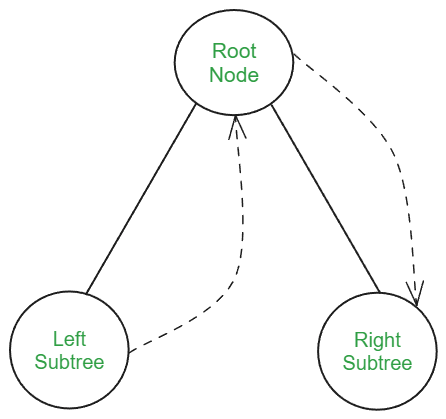|
A binary tree is a non-linear hierarchical data structure in which each node has at most two children known as the left child and the right child. As the binary tree has non-linear structure it can be traversed in multiple ways one such way is in-order traversal which is a depth first (DFS) traversal technique that follows the Left-Root-Right pattern.
In this article, we will learn how to implement in-order binary tree traversal in C++ and analyze its space and time complexity.
Inorder Traversal of Binary Tree in C++In-order traversal is a DFS tree traversal technique for the binary tree where the left subtree is traversed first followed by the root node and the right subtree at the end.
 Inorder Traversal - Traverse the left subtree.
- Visit the root node.
- Traverse the right subtree.
Consider the following example:
 Inorder Traversal Example For inorder traversal of the above tree:
- Start with the leftmost node, which is 4.
- Move up to its parent, which is 2.
- Visit the right child of 2, which is 5.
- Move up to the root node, which is 1.
- Finally, visit the right subtree, which is node 3.
So, the inorder traversal of the tree is: 4, 2, 5, 1, 3.
Algorithm for Inorder Binary Tree TraversalBelow is the algorithm of the inorder binary tree traversal:
inorder(TreeNode* root) {
if (root == NULL)
return;
inorder(root->left);
cout << root->val << " ";
inorder(root->right);
}C++ Program For Inorder Traversal of a Binary TreeThe following program illustrates how to implement the inorder traversal of a binary tree in C++.
C++
// C++ Program for inorder traversal of a Binary Tree
#include <iostream>
using namespace std;
// BINARY TREE IMPLEMENTATION
// Class definition for a binary tree node
class Node {
public:
int data;
Node* left;
Node* right;
// Constructor to create a new node
Node(int data)
{
this->data = data;
this->left = nullptr;
this->right = nullptr;
}
};
// Class definition for a binary tree
class BinaryTree {
public:
Node* root;
// Constructor to initialize the root
BinaryTree() { root = nullptr; }
// INORDER TRAVERSAL
// Function to perform inorder traversal
void inorderTraversal(Node* node)
{
if (node != nullptr) {
inorderTraversal(node->left);
cout << node->data << " ";
inorderTraversal(node->right);
}
}
};
int main()
{
// Initialize a binary tree
BinaryTree btree;
btree.root = new Node(1);
btree.root->left = new Node(2);
btree.root->right = new Node(3);
btree.root->left->left = new Node(4);
btree.root->left->right = new Node(5);
// Perform the inorder traversal
cout << "The inorder traversal of the binary tree is:"
<< endl;
btree.inorderTraversal(btree.root);
cout << endl;
return 0;
}
OutputThe inorder traversal of the binary tree is:
4 2 5 1 3
Time Complexity: O(N), here N denotes the total number of nodes in the binary tree because we visit each node exactly once.
Auxiliary Space: O(1), if the recursive stack space is not considered. If the stack space is considered then O(log N), for a balanced tree and O(N) for a skewed tree.
Refer to this article for more detailed time and space complexity analysis.
Applications of Inorder TraversalFollowing are some of the common applications of inorder traversal:
- Copying and Cloning: In-order traversal can be used to create a copy of the binary tree or to clone it by visiting each node in the correct order.
- Sorted Elements: The inorder traversal of a binary search tree always returns the elements in non-decreasing sorted order.
- Expression Trees: Inorder traversal is used to retrieve the infix expression from an expression tree, which is important in expression evaluation and compiler design.
- Counting Nodes in a Range: It can be used to count the number of nodes within a certain range in a BST by skipping unnecessary subtrees.
Related Articles:You can go through these articles to improve your understanding about the inorder traverals:
|


